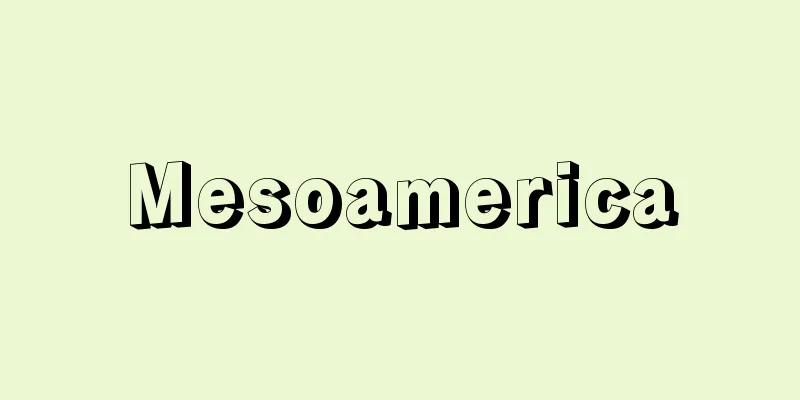Mesoamerica

|
An ancient pre-Hispanic civilization in Central America. Its area includes the southern half of Mexico, Guatemala, Belize, and all of El Salvador, as well as the western parts of Honduras, Nicaragua, and Costa Rica. Around 2000 BC, settled villages were formed and pottery production began, and around 1000 BC, common cultural elements appeared, such as pyramids and temples, ball games, pictographs, a 365-day solar calendar, and the cultivation of a wide variety of plants, including the four major plants (corn, beans, chili peppers, and pumpkins). The creation of a "Stone Age urban civilization" is unusual in world history, and exchanges with neighboring regions, particularly the Andean region of South America (Andean civilization), have been confirmed. The Formative or Preclassic period (1200 BC - 100 BC) was a period of development from settled villages to cities with public buildings, and the Olmec culture is a representative example. The following Classic period (100 BC - 1000 AD) was the most prosperous period when large cities appeared, and is represented by the Teotihuacan, Toltec, and Maya cultures. The following Post-Classic period (1000 - 1521) was marked by chaos caused by the invasion of the Chichimeca people from northern Mexico, and the Mexica culture of their descendants, the Aztecs. In the first half of the 16th century, the region was conquered by Spain, and Mesoamerican history and culture underwent major changes. However, Mesoamerican culture did not disappear, and its traditions continue to this day. Related topics: Adobe | American Indian | Tortilla | Pyramid Source : Heibonsha Encyclopedia About MyPedia Information |
|
中米における先スペイン時代の古代文明圏。メキシコ南半部,グアテマラ,ベリーズ,エルサルバドルの全域,ホンジュラス,ニカラグア,コスタリカの西側部分を範囲とする。前2000年ころから定住村落が形成されて土器製作も始まり,前1000年ころからピラミッド・神殿,球技,絵文字,365日の太陽暦,四大植物(トウモロコシ,豆,トウガラシ,カボチャ)を含む多種の植物栽培など共通の文化要素群が出現。〈石器時代の都市文明〉をつくったことは世界史のなかでは異例で,周辺地域,とりわけ南米アンデス地方(アンデス文明)との交流も確認されている。形成期または先古典期(前1200年―前100年)は,定住村落から公共建築をもつ都市への発展時代で,オルメカ文化が代表的。続く古典期(前100年―後1000年)は大都市が出現し最も繁栄した時代で,テオティワカン文化,トルテカ文化,マヤ文化が代表的。続く後古典期(1000年―1521年)はメキシコ北部からのチチメカ族の侵入による混乱と,その一族のアステカ族によるメシカ文化が代表的である。16世紀前半,この地域はスペインによって征服され,メソアメリカの歴史・文化は大きく変容した。ただし,メソアメリカの文化は消滅したわけではなく,その伝統は今日にまで及んでいる。 →関連項目アドベ|アメリカ・インディアン|トルティリャ|ピラミッド 出典 株式会社平凡社百科事典マイペディアについて 情報 |
<<: Mesosaurus - Mesosaurus (English spelling)
>>: Mesembryanthemum (female fairy) - Mesembryanthemum
Recommend
Mechanics of materials
Along with thermodynamics, fluid mechanics, and v...
Utsunoya Pass - Utsunoya Pass
A pass between Utsunotani in Suruga Ward, Shizuok...
Fan bone - Senkotsu
〘Noun〙① The bones of a fan. Made from bamboo, hard...
wisdom teeth
…the third molars (also called wisdom teeth) of t...
Bos primigenius (English spelling)
...The cave paintings of Altamira, which are pain...
Sayagata - Sayagata
A type of pattern. It is a type of manji pattern,...
pond
...In small hollows and flooded pools, mosses suc...
Ivy leaves at Utsunoya Pass - Ivy leaves at Utsunoya Pass
A Kabuki play. A domestic drama. Five acts. Writt...
Ross, H.
…An American weekly magazine. Founded in 1925 by ...
Wagadake - My Only
A mountain in the western part of Iwate Prefecture...
Shinkyokusho - Shinkyokusho
This is one of the collections of haiku (banquet s...
Gone with the Wind (film) - Gone with the wind
...In Hollywood, which was entering its Golden Ag...
Kidai - Kidai (English) yellowback seabream
This marine fish belongs to the order Perciformes...
Milescu, N.
…Moldavian writer and humanist of noble birth. Kn...
Fallen - Tofuku
When crops fall over due to wind or rain while the...



![Sefuri [village] - Sefuri](/upload/images/67cc06568fbb3.webp)





